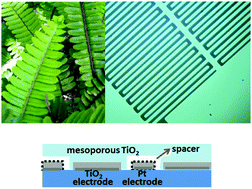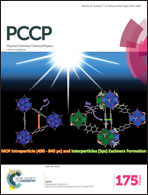Metal-based bracken-like single-sided dye-sensitized solar cells with horizontal separation†
Abstract
One of the drawbacks of typical dye-sensitized solar cells (DSCs) is their high cost and the high electrical resistance of the transparent conducting substrate. In conventional sandwich-type DSCs, only one of the FTO substrates can be replaced by a metal substrate. We investigated an all-metal-electrode single-sided DSC in which interpenetrated bracken-like Cr electrodes were created using photolithography; mesoporous TiO2 and Pt films were deposited on the laterally separated electrodes. Thermal Pt deposition and electrodeposition methods were investigated and it was found that a cyclic electrodeposition method resulted in selective Pt deposition at room temperature with a higher device performance. Cu or ZnO sacrificial layers and TiO2 or TiO2/SiO2 porous layers were used for the spacer layer that keeps the Pt electrode away from the TiO2 mesoporous layer and the optimum results were obtained when a TiO2/SiO2 layer was used. The best device had a current density of 8.47 mA cm−2, an open circuit voltage of 0.685 V and an efficiency of 2.44%. The results of open circuit voltage decay and electrochemical impedance spectrometry showed the formation of a high-resistivity blocking layer, which was attributed to the Cr oxide formed during thermal treatment. The efficiency may be improved further by developing low-temperature fabrication processes.


 Please wait while we load your content...
Please wait while we load your content...